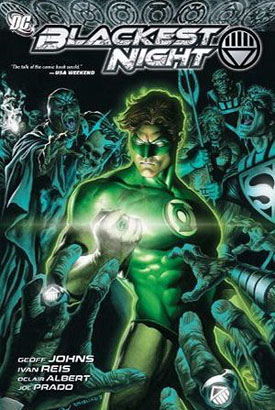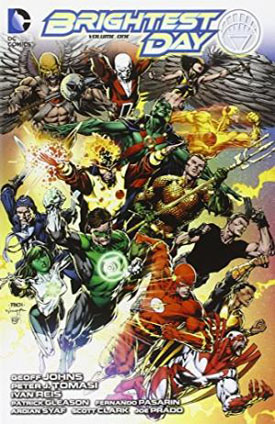 Blackest Night and Brightest Day mark another DC “crossover event” in which pretty much everyone gets reinvented. These have become almost a requirement in superhero comics, I suspect because of the periodic necessity of reconciling the various universes occupied by all those superheroes — and their various reinvented alter-egos.
Blackest Night and Brightest Day mark another DC “crossover event” in which pretty much everyone gets reinvented. These have become almost a requirement in superhero comics, I suspect because of the periodic necessity of reconciling the various universes occupied by all those superheroes — and their various reinvented alter-egos.
Blackest Night actually begins before the story does, at the end of the Sinestro Corps war. There’s a prophecy that the Green Lanterns and the Sinestro Corps will be joined by five more groups of Lanterns, each driven by a different emotional power, to fight a “War of Light” that will destroy the universe.
Well, that’s not exactly how it turns out.
We begin with Hal Jordan, one of Earth’s Green Lanterns, at the unmarked grave of Bruce Wayne: Batman is dead. (Sort of — you know how these things happen. See Batman: The Return of Bruce Wayne to find out what’s actually going on. He’s joined by the Flash (Barry Allen), who’s outraged at the lack of respect shown to Batman at his death. There are good reasons for this, but he’s still outraged, particularly in light of the huge memorial service held for him at his death.
Actually, it seems that a lot of superheroes have died and been resurrected, somehow. Remember that — it’s going to be important.
A short time later, we witness someone doing a little grave-robbing — whoever it is is after Batman’s skull, which will become a key element in the assault of the Black Lanterns. The Black Lantern Corps, the brainchild of Nekron, grows as dead superheroes are resurrected. They all get a black ring, and pretty much everyone eventually gets involved, dead or alive.
I may not be quite reverent enough, but from this vantage, this is a zombie story for fanboys. (Or fangirls: one of the women in my office got really excited when she saw this sitting on my desk.) The structure of the script is predicated on the assumption that the reader already knows everyone’s backstory — and pretty much everyone shows up, in short fragments that give us glimpses of what’s happening now. The kicker is, we don’t know any more than the heroes do. There is an overriding story line, but it’s effectively buried under details until well along in the narrative. (Zombies? Well, half these characters are dead, rotting flesh and all. And I lost it when I started hitting the frames of the black rings zooming through space chanting “Flesh! Flesh!” Think about that. I sure hope it was deliberate — it’s automatic camp.)
Ivan Reis’ pencils for this volume are superb, ably defined by inker Oclair Albert (with assists from other artists), but like the story, they all too easily dissolve into chaos. Frames are sometimes too densely packed with images to be legible at all.
 Brightest Day picks up where Blackest Night left off. Twelve heroes and villains have been provisionally resurrected, and each has an assignment that will, upon successful completion, make their resurrection permanent and work toward a larger purpose. Boston Brand (“Deadman”) is the thread that ties this one together. He’s somehow wound up wearing a white ring and serves as the observer who initiates each new episode.
Brightest Day picks up where Blackest Night left off. Twelve heroes and villains have been provisionally resurrected, and each has an assignment that will, upon successful completion, make their resurrection permanent and work toward a larger purpose. Boston Brand (“Deadman”) is the thread that ties this one together. He’s somehow wound up wearing a white ring and serves as the observer who initiates each new episode.
Once again, by necessity when you’re dealing with this many characters in this many different situations, it’s an episodic story, but vastly more coherent: the sections are longer and more detailed and begin to develop into intelligible narratives, and most of them hold our attention quite effectively. The loser, for me at least, is Firestorm: we have Ronnie Raymond and Jason Rusch occupying the same head and they don’t get along, mostly because they’re a couple of immature idiots. The images seem marked by greater clarity, as well. There are still some terrifically dense frames, but they manage not to dissolve into incoherence, and on the whole the visual flow is much smoother. It’s fan stuff again, but at least outsiders have a chance.
In fact, Brightest Day has enough going for it that I’m actually looking forward to Volume 2. And for those who want to know just who’s involved in these stories, the Wikipedia entries have, among other details, character lists — although the entry for Brightest Day makes a mistake at the beginning of the plot summary.
(Both DC Comics, 2011)
